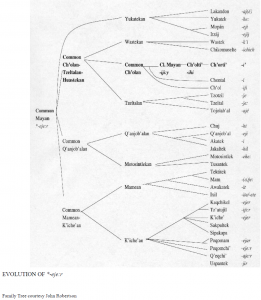Christy Barber and Dr. John Robertson, Linguistics
Common Mayan had a suffix, *-e:r, which was an adverbial deictic clitic indicating past tense. (1) Its
form and function remained fairly regular throughout the evolution of Common Mayan into more than 30 distinct languages. This study focuses on its evolution in the construction #-TIME-e:r, a Mayan phrase meaning “# days ago,” and that of its complementary phrase #-TIME, meaning “# days from now.” The most frequently occurring construction uses a form of the morpheme *-e:j “day,” as in Colonial Kaqchikel coh-eh-er “four days ago.”
The evolution of these particles generally followed sound changes typical to the various Mayan language families. Ch’olan and Motosintlekan languages changed the vowels from e to i, although this occurred only in limited instances in Motosintlekan. The Ch’olan change was the result of a paradigmatic shift from long e to long i throughout Ch’olan languages (John Robertson, personal communication). Q’eqchi’ alone among K’iche’an languages lowered the initial vowel from e to a, but conserved e in the final vowel position: ca:b-a:j-e:r ‘2 days ago=. There is a regular variation throughout most of the language families in constructions for the numbers 5 and 7. The reconstructed suffix for these two numbers is *- ixir. In the several languages where this variation exists, the vowels in stay the same almost without exception, the x does not change, and the final r typically drops off (though in Mamean languages it changes from r to t as in Ixil Cotzal ob’-ixte ‘five days ago’). Some K’iche’an languages also exhibit a variation unique to the numbers two and three, wherein i replaces e for both of the suffix vowels. This is demonstrated in comparison between Kaqchikel kab=-ij-ir >two days ago= and kaj-ej-er ‘four days ago’.
The same construction is possible for periods of years and months instead of days. The expression ‘# years ago’ is formed by substituting the morpheme *-ab’ ‘year’ for *-e:j. In Tz’utujil, ox-ij-i:r is ‘three days ago, compared to ox’-ab’-i:r ‘three years ago’. (The bolded morphemes are those which mark the time period as days or years.) Similarly, reflexes of the Common Mayan word *winaq ‘twenty’, which also means ‘month’ (the Maya month is twenty days long), can be inserted to indicate a number of months past or future. The Tz’utujil phrase ju:-winaq-ij-i:r means ‘one month ago’ (literally ‘one twenty-days ago’).
Similar expressions are found in many Mayan hieroglyphic texts. These expressions are commonly known as “Distance Numbers,” because they move events in the narrative timeline forward or backward a certain “distance.” Their form matches the form of the spoken expression, as on NAR HS. 1:Ua 13-UINAK-ij/JI-ya 13 uinakiji:y ’13 months ago’. The expression in Ch’olti’, chacbihi ‘two days ago’, is morphologically the same, although the final vowel has been shortened. A distributional analysis (in progress) of these phrases in the corpus of Mayan hieroglyphic inscriptions, combined with comparative linguistic data, has potential to refine the understanding of Distance Number construction and use.
NOTE: Mayan transcriptions are written based on Spanish orthography, following tradition. A colon after a vowel indicates that the vowel is lengthened. A star before a word or morpheme indicates that it is a reconstruction based on data comparison and analysis.

